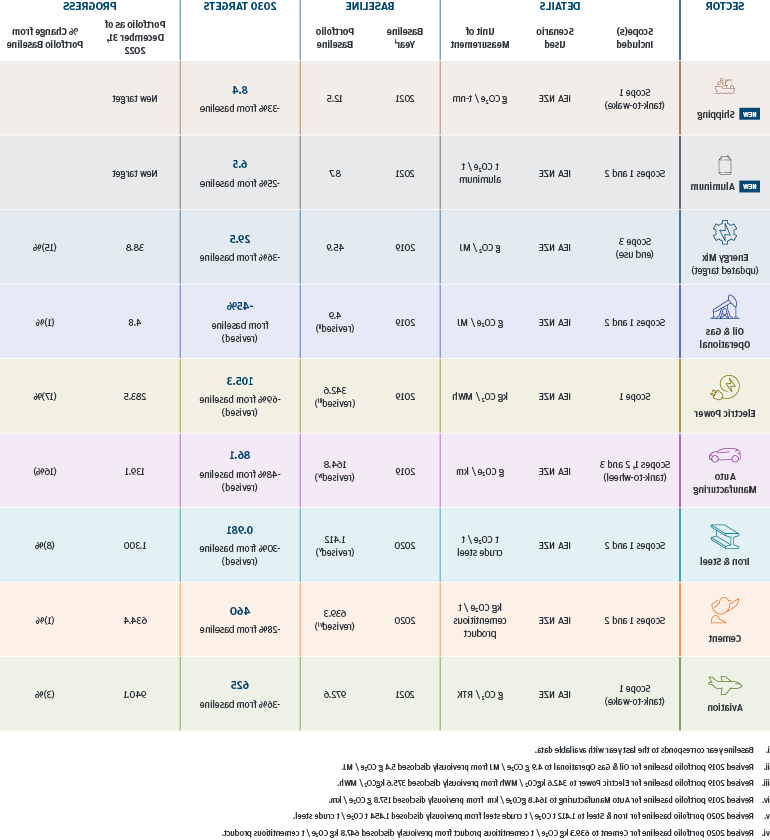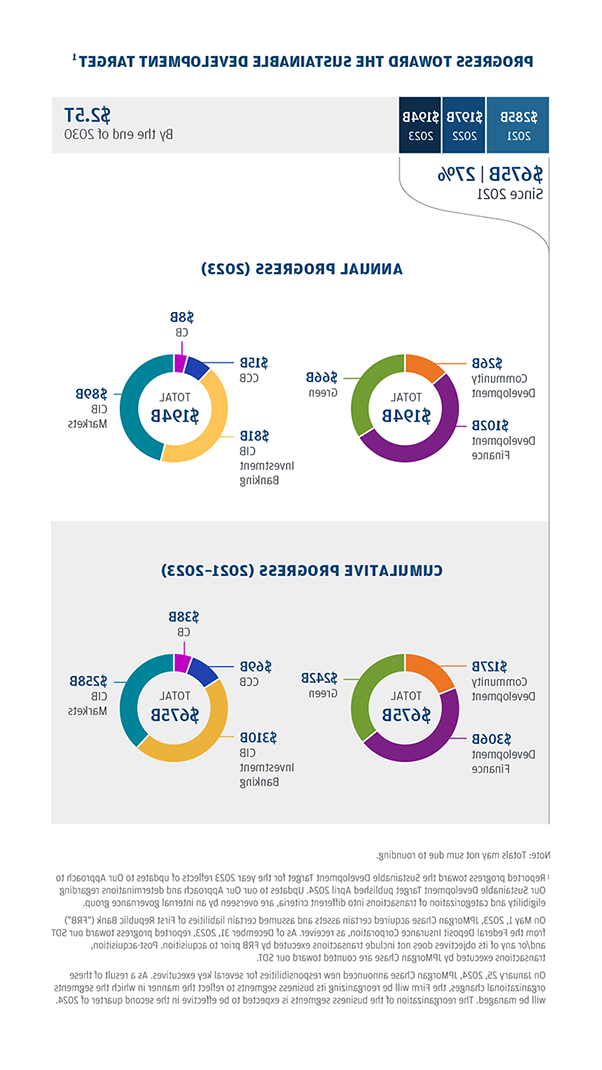The 2023 Environmental Data table provides an overview of JPMorganChase's operational greenhouse gas (“GHG”) emissions and electric power usage for 20231 and 20172 as baseline year.
Scope 1 GHG emissions, which include direct emissions from sources such as natural gas, propane, fuel oil, jet fuel, fugitive emissions, diesel, fleet4, and other energy use5, increased to 115,294 mtCO2e3 from 84,463 mtCO2e in the 2017 baseline.
Scope 2 GHG emissions (location-based), which are indirect emissions from purchased electricity and steam, district heat, and chilled water, decreased to 792,479 mtCO2e3 from 944,641 mtCO2e in the 2017 baseline.
Combined Scope 1 and Scope 2 (location-based) emissions totaled 907,773 mtCO2e in 2023, a 12% reduction from the 2017 baseline. Our target is to reduce Scope 1 and Scope 2 (location-based) GHG emissions by 40% by 2030 from the 2017 baseline.
GHG emissions intensity6 for 2023 was 5.7 mtCO2e/million USD revenue, down from 10.3 mtCO2e/million USD revenue in 2017.
Scope 2 GHG emissions (market-based), which are indirect emissions from purchased electricity and steam, district heat, and chilled water, decreased to 3,642 mtCO2e3 from 858,769 mtCO2e in 2017.
Scope 3 emissions from business travel7 increased to 255,481 mtCO2e3 in 2023 from 187,713 mtCO2e in the 2017 baseline.
The combined Scope 1, Scope 2 (market-based), and Scope 3 GHG emissions for 2023 was 374,417 mtCO2e3.
The Firm purchased 374,417 mtCO2e3 of verified carbon offsets8 to address unabated emissions.
In 2023, purchased electricity decreased to 2,016,262 MWh3 from 2,154,995 MWh in the 2017 baseline.
In 2023, on-site solar electricity production increased to 47,443 MWh from 2,598 MWh in 2017.
The percentage of total electric power needs met with on-site generation and long-term renewable electricity contracts was 36% in 2023. Our target is to satisfy at least 70% of our renewable electricity goal with on-site renewable electricity and off-site long-term renewable electricity contracts by 2025.9
Purchased renewable electricity10 increased to 2,016,262 MWh3 from 200,000 MWh, combined with our on-site electricity production, resulted in 100% of electric power use from renewable sources, up from 9% in the 2017 baseline.
Footnotes:
- For 2023, we have updated the methodology we use to estimate our operational GHG emissions.
- Data for 2017 has not been subject to external verification and may be revised.
- We engaged an external third-party to perform a limited assurance engagement over these metrics presented for 2023.
- For 2017, emissions from fleet were not updated to the current methodology due to data limitations. Total emissions from fleet accounted for approximately 0.06% of the overall Scope 1 emissions and 0.005% of the overall Scope 1 and Scope 2 (location-based) emissions for 2017.
- Includes heavy fuel oils, anthracite coal, biofuels and waste.
- Includes Scope 1 and Scope 2 (location-based) GHG emissions; mtCO2e/million USD revenue.
- For 2023, Scope 3 Category 6 - Business Travel includes: air and rail travel, car rental, ride share, expensed mileage and hotel stays. For 2017, Scope 3 Category 6 - Business Travel includes only air travel data. Due to data limitations, and to align with our updated emissions methodology, we applied the percentage breakdown of haul distances and cabin classes from 2023 air travel data as a proxy to calculate 2017 air travel emissions.
- Carbon offsets, also referred to as "carbon credits," and the market for them are evolving rapidly. Although we endeavor to source high-quality carbon credits verified by independent third parties, the ability to use carbon credits to fully and permanently address unabated emissions relies on certain assumptions and is subject to debate among experts.
- Tracking began in 2021.
- Purchased renewable electricity from unbundled energy attribute certificates, contractual instruments which included long-term power purchase agreements, virtual power purchase agreements and renewable supply contracts.






